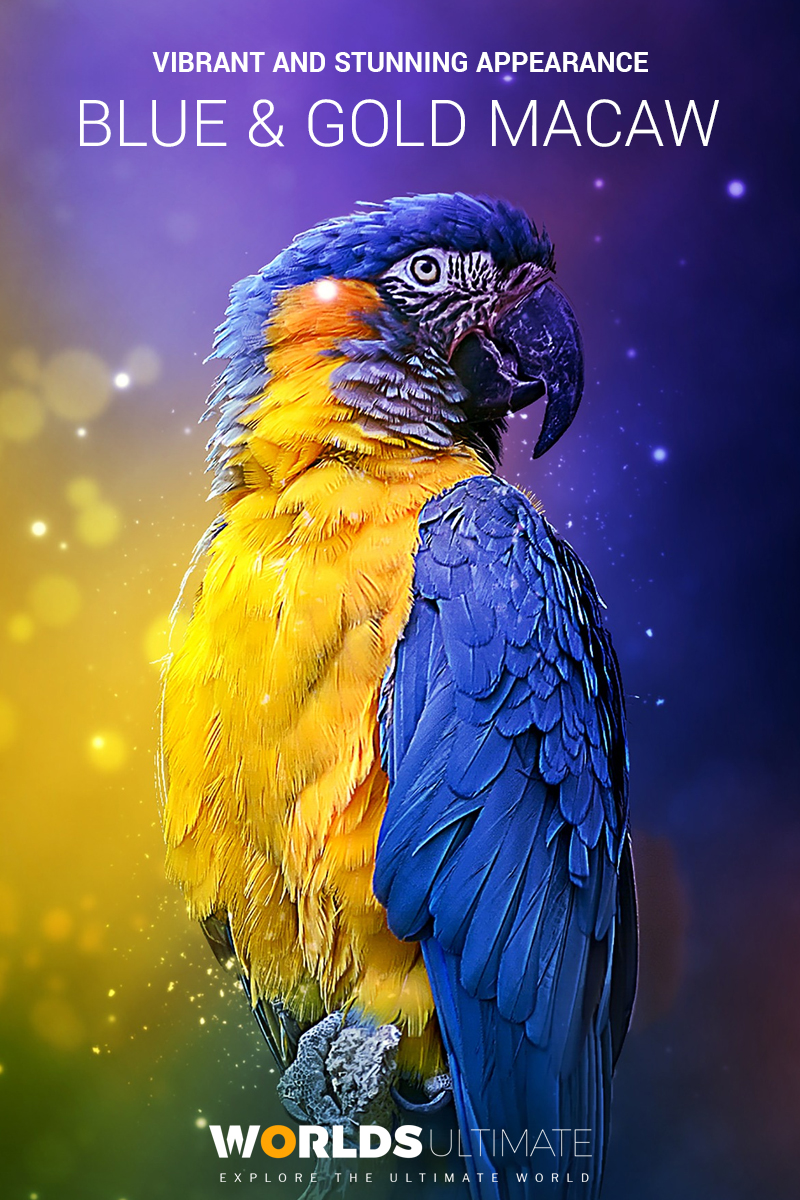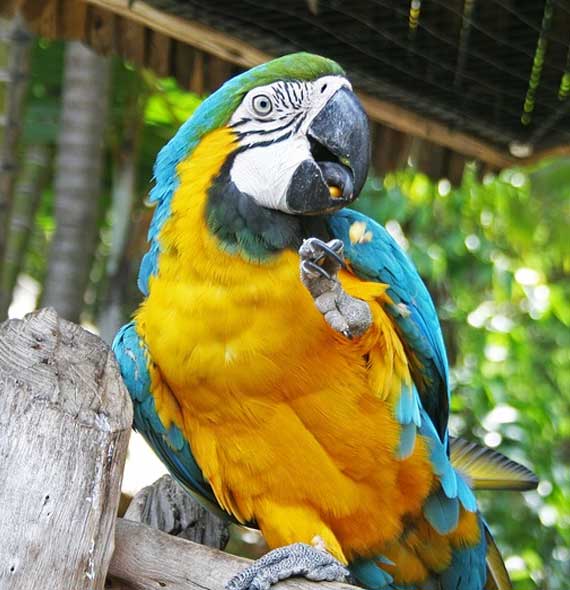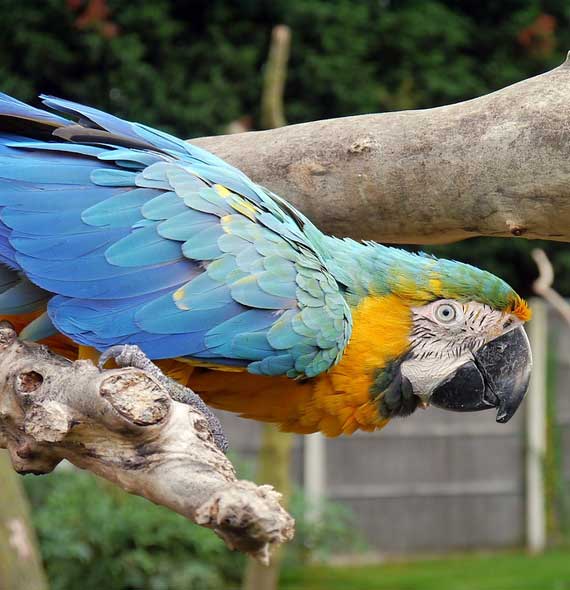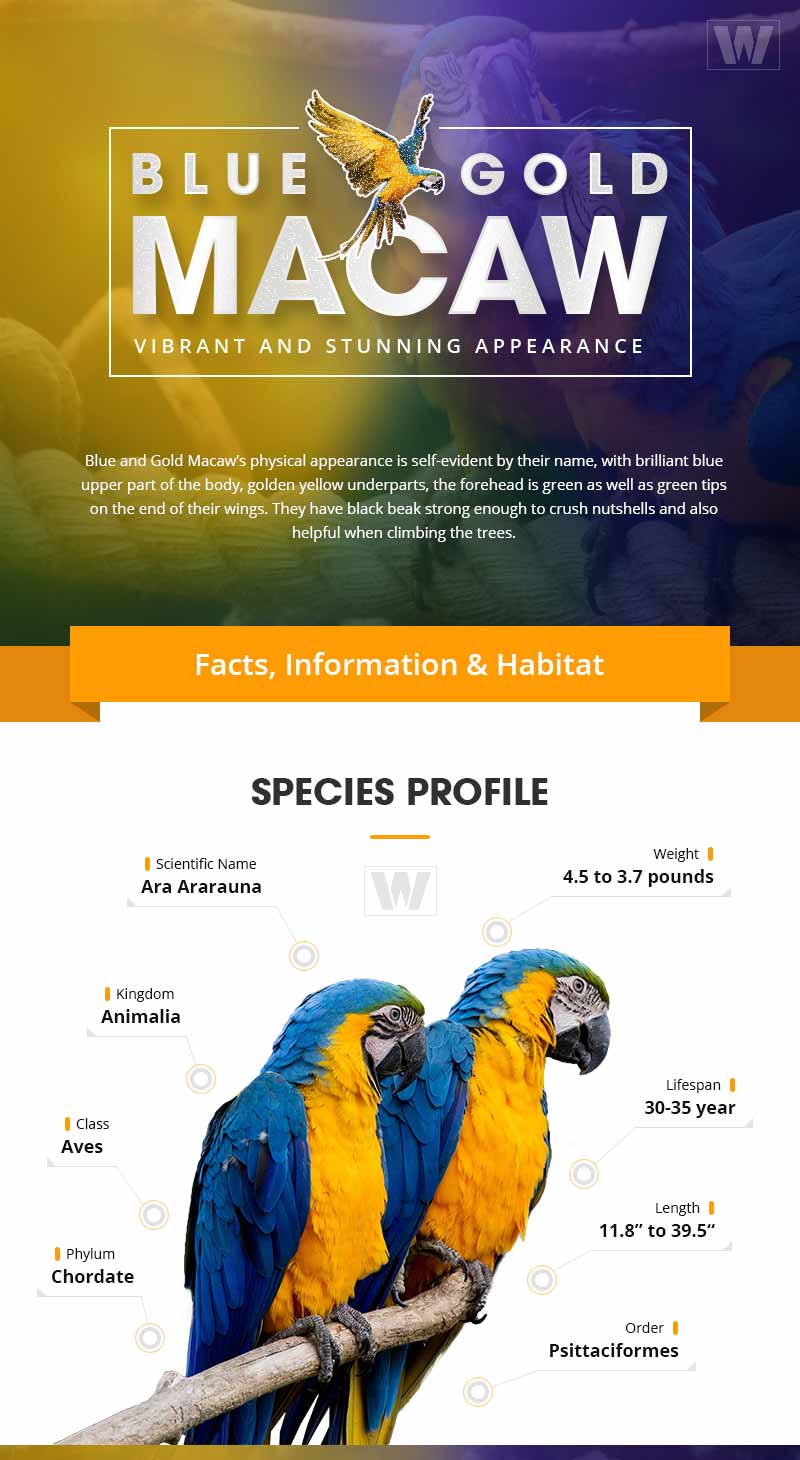The Vibrant Blue and Gold Macaw with Stunning Appearance
Today I will discuss another family member of Macaws named as Blue and Gold Macaw also known as Blue and Yellow Macaw. It is one of the six genera of Central and South American Macaws.
With feathers as bright as a tropical sunset, the blue-and-gold macaw, whose scientific name is Ara ararauna, is one of the most spectacular representatives of the parrot family. These dazzling birds are famous for their intelligence, emotional depth, and vibrant companionship with humans.
Apart from their obvious beauty, Blue and Gold Macaws symbolize both the resilience and diversity found in Amazonia. In this article, we look into their world, from their wild habitats and diet to conservation, behavior, and what it takes to care for them.
Blue and Gold Macaw Information & Habitat
Blue and Gold Macaw’s physical appearance is self-evident by their name. With a brilliant blue upper part of the body, golden yellow underparts, the forehead is green, with the same wing tips. They have a black beak strong enough to crush nutshells and also helpful when climbing trees.
Their face is white with small black feathers which change into pink color when they are excited. They also have a small patch of dark blue to black feathers under the beak. They have dark grey to black zygodactylous feet (two toes facing forward and two backward) that help to hold tree branches firmly while moving.
Blue and Gold Macaw generally weight between 0.9 to 1.8kg and measure about 30 to 34 inches long. Starting from the tip of its head to the end of its tail, so more than half of which is tail. They have a wingspan of 41 to 45 inches. Males and females are alike so it’s really hard to differentiate. Some suggest clues but they are not authentic and still prefer to do DNA test for identification.
Lifespan
Most of the resources show that Blue and Gold Macaw can live up to 30 to 35 years in the wild. But it can extend up to 50 to 60 years when a macaw is kept as a pet in the home. Because there is no threat to their life from predators.
Table of Contents

Species Profile
| Scientific Name | Ara Araruna |
| Family | Psittacidae |
| Kingdom | Animalia |
| Phylum | Chordate |
| Class | Aves |
| Order | Psittaciformes |
| Genus | Ara |
| Average Weight | 0.9 to1.8 kg |
| Length | 30 to 34 inches |
| Wingspan | 41 to 45 inches |
| Lifespan (Wild) | 30 to 35 years |
| Lifespan (Captivity) | Up to 60 years |
| IUCN Status | Least Concern (Population decreasing) |
Status
Blue and Gold Macaw is of at least concern in the IUCN Red List of Threatened Species, but their population is declining. The decline is not rapid enough to reach a vulnerable status. Research shows that the adult Blue and Gold Macaw is greater than 10,000.
The decline is less than 10% over the past 10 years. Although they are declared as uncommon species and are suspected of a loss of habitat over the next three generations due to deforestation and the capture of wildlife to keep as a pet in the home.
Habitat
Blue and Gold Macaw exists in subtropical and tropical forest, native to Central and South America. Where they live in woodland and savannah. This species range from Venezuela to Brazil, Bolivia, Columbia, Peru, Paraguay.
Previously they range in Trinidad too but in 1970. They were completely wipe-out due to human activities. They build their nest at height in dead palm trees to avoid predation. It’s an inspiring sign that even the liveliest colors can survive if humans show enough patience to let them do so.
The IUCN Red List, reports that the Blue and Gold Macaw as Least Concern. However, their numbers are declining due to habitat loss and the illegal bird trade.
Even though BirdLife International’s recent surveys show these magnificent birds thrive in certain parts of Brazil, Bolivia, and Paraguay, deforestation effectively destroyed their nesting sites close to the Amazon basin.
Blue and Yellow Macaw Care and Feeding
Modern bird veterinarians advise a balanced pelleted diet (60%), plus fresh fruits or vegetables / leafy greens (30%), and a portion of nuts plus seeds (10%).
Feed your birds such things as apples, mangoes, carrots, and bell peppers. Do not feed them avocados, chocolate, caffeine, or alcohol, all of which are harmful to them. A mineral block or cuttlebone supports calcium and assists in maintaining healthy beaks.
Ensure that the bird has access to clean, filtered water at all times, and change the water daily.
Blue and Gold Macaw is spectacular, intelligent, plus with their vibrant colors, with a large project commanding presence. Their ability to mimic words and socialize makes them more attractive to humans and builds a strong bond with the owner if looked after well. They require much more attention from the owner compared to traditional pets such as cats and dogs.
As it mentioned before that they are quite large, so a large cage is required for them; otherwise, they will ruin the feathers on their tail. They are very active parrots, so they need to be them outside the cage for several hours for playtime and to stretch their muscles.
They may require a bath daily, depending on the weather conditions. Strong toys must be provided for chewing to keep their jaw muscles healthy. It is preferable to keep them in a highly interactive area in the house so they can intermingle with family members.
Wildlife
In wildlife, Blue and Gold Macaw’s usually consume various seed, nuts, and fruits. They are a big fan of palm fruits, but also love to have seasonal vegetables. They eat clay and minerals on the riverbank like Blue Macaw and other Macaws. It helps them to digest the poison they intake while eating some toxic plants.
Captive Blue and Gold Macaws should be offered a varied diet, the same as wild ones. Seeds and nuts are rich foods, so avoid giving them as they don’t fly far to hunt for their food. Besides that, there is some pellet mix available for healthy consumption. They may like to share some food with you, so feel free to give them your food as long as it is healthy, such as fruits and vegetables.
| Clutch Size | Incubation Time | Fledging Age | Hatch Weight | Peak Weight | Weaning Weight |
| 2 to 4 | 24-25 days | 90-100 days | 14-20g (0.5-0.7 oz) | 927-1064g (32.4-37.2 oz) | 1000g (35 oz) |
| Nest Box Size | Horizontal box, 16″ x 16″ x 48″ (40.6cm x 40.6cm x 122cm) or 35 gallon (9.2 L) pickle barrel |
Housing
As we all know, Blue and Gold macaws are quite large, so they require large enclosures. An outdoor aviary is recommended because their feather requires natural sunlight to remain healthy. If they are kept indoors, make sure their cage is in a place where sunlight can come.
The size of the cage also depends on the amount of time they going to spend during the daytime. The material used in building an aviary should be strong enough to withstand the weather and the strong beak of Macaws. Different designs of aviaries are available to suit different circumstances.
Maintenance
Blue and Gold Macaws are quite messy and destructive. Good hygiene practice should be maintained to provide them a healthy life. The aviary should be clean on regular basis and old food shouldn’t be pilling up in the cage, on perches. Wash the food and water dishes daily and provide them fresh water regularly.
By practicing to keep the bird’s environment clean we can reduce the chance of developing a fungal infection and viral diseases.
hey require not just food and shelter but also daily mental engagement. Foraging toys, puzzle feeders, and rotating perches can help you keep your macaw mentally active and physically stimulated.
All of these are good things. Besides that, today’s avian enthusiasts also employ touchscreen games and positive reinforcement to teach commands and develop trust with their birds.

Each one of these parrots forms a deep emotional bond with his or her keeper and may be upset if left alone for too long. Spending regular, quality time with them – talking about things, training new things – keeps relationships calm and tranquil.
Social Behavior
In wildlife, Blue and Gold Macaws are generally found in pairs, family groups, or in small flocks, ranging between 20 to 25 birds. They fly together in a flock in a quest for food and can be seen peacefully with each other. They don’t have a leader to lead a group, so they are all equal and just move around together. Especially, the paired parrot flies very close together, touching their wings to their partners.
Related Pick: How to Teach Your Macaw to Talk?
Blue and Gold Macaws are sweet and perform very well as a pet if raised properly. The owner should have detail information about their behavior before taking a decision to have them as a pet. Because we all know that they love to live in groups and also very affectionate so they require a lot of attention from their owners.
These attractive, intelligent creatures, capable of mimicry from laughter to household sounds, make for a good pet. They bond tightly with humans and are happy when included in daily life patterns.
But their cleverness also brings problems – if they are not stimulated or given attention, they may shout their heads off, chew up furniture, or even throw the food. Training through positive reinforcement and getting into the rhythm of everyday life helps manage such behavior.
Remember, these are not “ornamental birds” but lifelong companions who need opportunities to interact and be useful.

Potential Problems
Research shows that Blue and Gold Macaw is a friendliest companion. But as we all know that there are always some positive and negative characteristics. So, the owner should consider some features of their natural behavior before keeping them as a pet. They are indeed very intelligent.
They can easily learn 15 to 20 words and love to chatter, which means they are quite loud. In addition to speaking the whole day, they can scream too when they are not in a good mood, and it’s being observed that the screaming gets louder at sunset. Once they came to know that while screaming they can easily grab your attention, they will make a habit.
Biting and chewing is also a natural behavior which can be tamed with affection and training. As soon as the young once out of their baby stage will start exploring their beak. If their nipping is not properly looked after, a high risk of developing a biting habit into a potential problem. They are incredible chewer so if you leave them alone at home you will find lots of destruction on your arrival.
Develop a habit of putting them in a cage while they are alone at home. Also provide them with toys and another thing to chew on. Keep an eye while you are at home and redirect them to chew the suitable toys if you see them chewing on furniture. They also have an issue of plucking their own feather. They usually do this when they are bored or something bothering them. It is preferable to take them to the veterinarian for an examination to maintain their health.
Breeding
Blue and Gold Macaw is a monogamous species, meaning they believe in lifetime commitment, so once they pair up, they stay together; however, they might replace their mate if they lose. They reach sexual maturity at the age of 3 to 4 years. Their mating season starts in January and ends up by June and they usually breed about every 1 to 2 years.
Read More: Birds of the Amazon jungle
Blue and Gold Macaws build their nests in cavities and holes quite high above the ground. Female, in general, lay 2 to 3 eggs and they incubates them approximately 25 to 28 days whereas father hunt and brings back food to the nest during the period of incubation. Chick hatch blind with pink skin and no feathers. Among all only one chick will be dominant and survive and the rest died due to starvation.
Mother will stay close to keep them comfortable till they develop their feathers for warmth and protection. The hatchling weighs about 14 to 20g, and it develops feathers after 10 days. Parents are very protective of their young ones. Chicks can leave the nest independently within 3 to 4 months when they are old enough to feed themselves. Once they reach maturity, they make a pair and build up the nest to repeat the life cycle.
Handling/training
Blue and Gold Macaws are quite popular as pets due to their eye-catching appearance and talking ability. There is no doubt that they are one of the friendliest and intelligent companion parrots, but the owner needs to work hard to get the best out of them.
Once you bring them home, give them some time to settle down in a new environment and also to get used to your family members. This can be done with a little bit of training, spending 2 to 3 minutes with them daily by each family member, and offering a small treat. While training them, make sure to be patient and consistent and try to build trust. Never hit them, as you’re going to break their trust. Train them ina session, and it should not be longer than 15 to 20 minutes.
Availability:
Blue and Gold Macaws are the most common choice among people to bring them into their homes. It is not hard to find them because they breed very well in captivity so that’s why they are available in the market direct from a breeder.

Embed Blue and Gold Macaw Infographic on your Blog!
Just Copy and Paste Below code!
Conservation & Ecotourism
Conservation and community-based conservation, however, have once again brought them hope. Seen in Peru’s Tambopata Reserve and Brazil’s Pantanal, guided bird-watching trips enable tourists to watch flocks of macaws taking advantage of the natural licks of mineral-rich clay.
Those smart projects not only fund habitat recovery but also deter the illegal wildlife trade. Each responsible traveler helps ensure that our grandchildren will still gaze at these dazzling birds, soaring high and free in Amazon skies.
FAQs
The macaws lose nearly a quarter of their eggs to predators, including Purplish Jays, White-eared Possums, Coatis, Eagles and Human hunts
Blue and Gold Macaw live between 30 and 35 years in the wild. As pets or at zoos, these birds can live upwards of 60 years with proper diet and care.
Blue and Gold macaws usually consume various seed, nuts, and fruits. Like walnuts, peanuts, pecans, Brazil nuts, pine nuts; corn on the cob, banana, orange; slices of wholemeal bread, cubes of cheese.
Blue and Gold Macaw isn’t an endangered species at this time, Blue and Gold Macaw are at least concern in IUCN red list of threatened species, but their population starts declining.
Yes! Many of these birds develop large vocabularies and mimic their owner’s voices with startling accuracy.
References
- www.iucnredlist.org
- https://www.oiseaux-birds.com/card-blue-yellow-macaw.html
- https://pets.thenest.com/diet-blue-gold-macaw-parrot-11749.html
- https://lafeber.com/pet-birds/species/blue-and-gold-macaw/
- https://en.wikipedia.org/wiki/Blue-and-yellow_macaw


Wow
Cool but i am only ten and i love birds but i would like a military macaw but my parents wont get me one
That’s awesome that you love birds! Military macaws are amazing, but they require a lot of care, space, and attention, which is why your parents might be cautious. Maybe you can learn more about them and show your parents how you’d take care of one in the future!